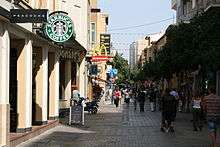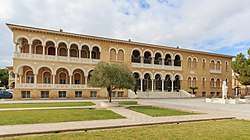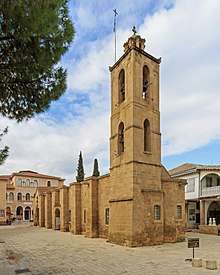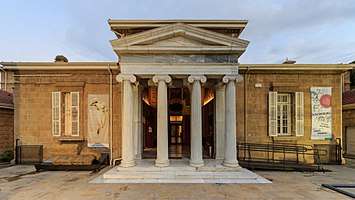Nicosia
Nicosia (/ˌnɪkəˈsiːə/ NIK-ə-SEE-ə; Greek: Λευκωσία, romanized: Lefkosía [lefkoˈsi.a]; Turkish: Lefkoşa [lefˈkoʃa]) is the largest city, capital, and seat of government of Cyprus. It is located near the centre of the Mesaoria plain, on the banks of the River Pedieos.
Nicosia | |
|---|---|
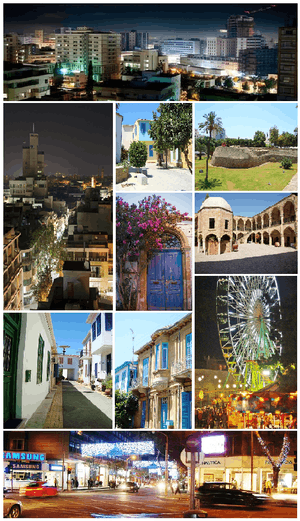 From upper left: Nicosia city skyline, Ledra Street at night, courtyard of Nicosian houses, Venetian walls of Nicosia, a Nicosian door in the old town, the Buyuk Han, a quiet neighbourhood in the old town, Venetian houses, Nicosia Christmas fair, Makariou Avenue at night | |
 Flag  Seal | |
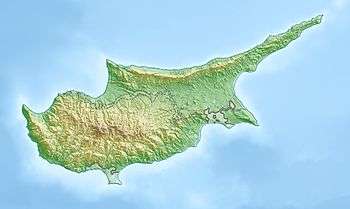 Nicosia Location of Nicosia in Cyprus 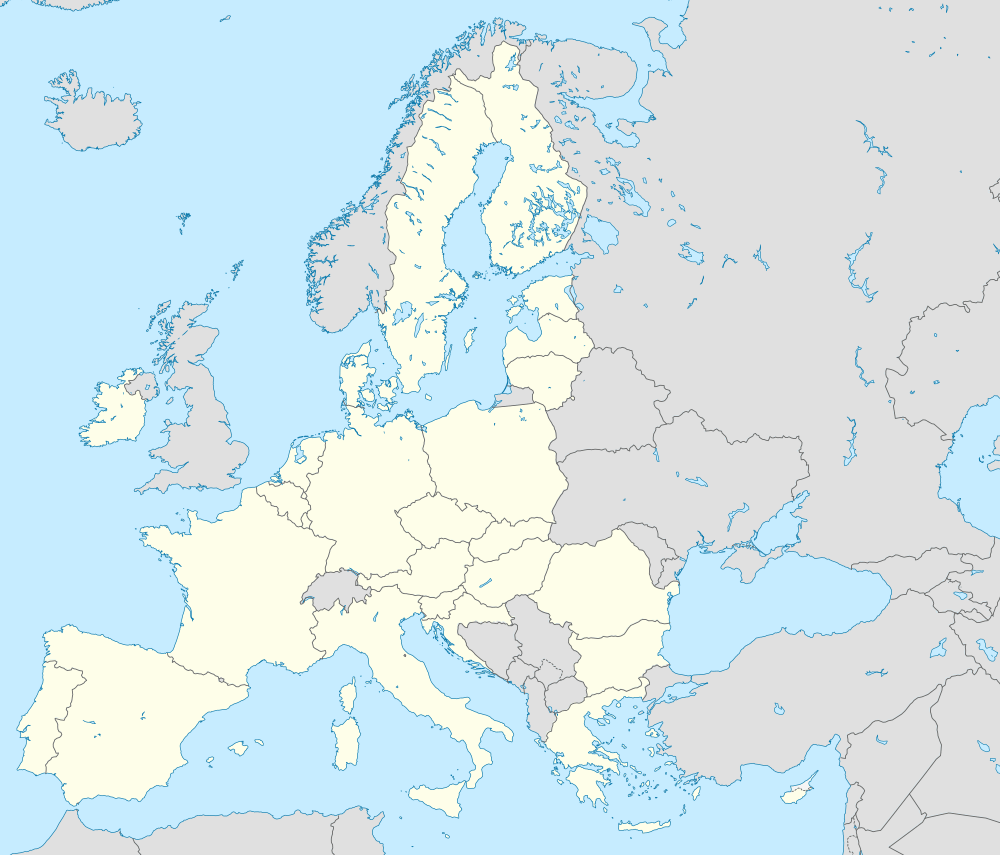 Nicosia Nicosia (European Union) 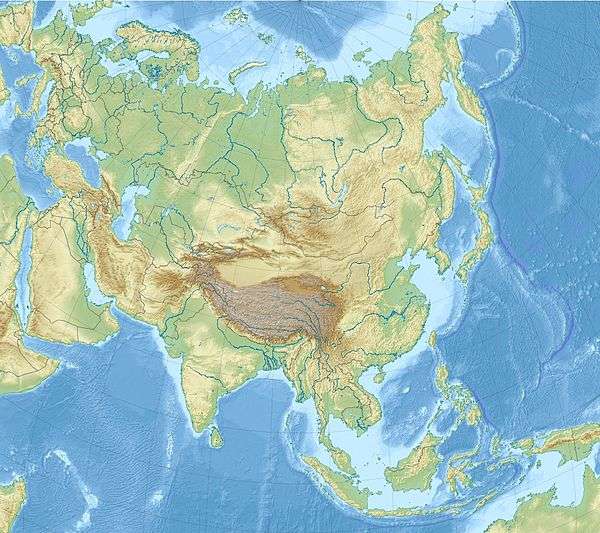 Nicosia Nicosia (Asia) | |
| Coordinates: 35°10′21″N 33°21′54″E | |
| Claimed by |
|
| Administered by | |
|
|
| Cypriot District | Nicosia |
| Government | |
| • Mayor of Nicosia Municipality | Constantinos Yiorkadjis (Ind.) |
| • Mayor of Nicosia Turkish Municipality | Mehmet Harmancı (TDP) |
| Elevation | 220 m (720 ft) |
| Population | |
| • Capital city |
|
| • Urban |
|
| The south's urban includes the municipalities of Nicosia (south), Agios Dometios, Egkomi, Strovolos, Aglantzia, Lakatameia, Anthoupolis, Latsia and Yeri. The north's includes North Nicosia, Gönyeli, Gerolakkos and Kanli. | |
| Demonym(s) | Nicosian |
| Time zone | UTC+2 (EET) |
| • Summer (DST) | UTC+3 (EEST) |
| Post code | 1010–1107 |
| Area code(s) | +357 22 |
| ISO 3166 code | CY-01 |
| Website | Nicosia Municipality |
Nicosia is the southeasternmost of all EU member states' capitals. It has been continuously inhabited for over 4,500 years and has been the capital of Cyprus since the 10th century. The Greek Cypriot and Turkish Cypriot communities of Nicosia segregated into the south and north of the city respectively in early 1964, following the fighting of the Cyprus crisis of 1963–64 that broke out in the city. This separation became a militarised border between the Republic of Cyprus and Northern Cyprus after Turkey invaded the island of Cyprus in 1974, occupying the north of the island, including northern Nicosia. Today North Nicosia is the capital of Northern Cyprus, a state recognized only by Turkey, that is considered to be occupied Cypriot territory by the international community.
Apart from its legislative and administrative functions, Nicosia has established itself as the island's financial capital and its main international business centre.[3] In 2018, Nicosia was the 32nd richest city in the world in relative purchasing power.[4]
Toponymy
The earliest mention of Nicosia is in the clay prism of the Assyrian king Esarhaddon in 672 BC. This is a mention to the city-state of Ledra located on the site of Nicosia, and the city is named "Lidir". The name Ledra and variations (such as Ledroi) remained in use as late as 392 AD, when it was used in writing by Saint Jerome. However, that text also refers the city as "Leucotheon", and early Christian sources of this period are the first to use similar variations of the name Lefkosia (e.g. Leuteonos).[5] The origin of the name "Lefkosia" is considered by scholars to be a "toponymic puzzle". The name is recorded in the majority of Byzantine sources as "Leukousia", and it is accepted in literature that the name "most probably" derives from the Greek phrase "leuke ousia" ("white estate").[6]
History
Ancient times
Nicosia has been in continuous habitation since the beginning of the Bronze Age 2500 years BC, when the first inhabitants settled in the fertile plain of Mesaoria.[7] Nicosia later became a city-state known as Ledra or Ledrae, one of the twelve kingdoms of ancient Cyprus built by Achaeans after the end of the Trojan War. Remains of old Ledra today can be found in the Ayia Paraskevi hill in the south east of the city. Only one king of Ledra is known: Onasagoras. The kingdom of Ledra was destroyed early. Under Assyrian rule of Cyprus, Onasagoras was recorded as paying tribute to Esarhaddon of Assyria in 672 BC. By 330 BC, Ledra was recorded to be a small unimportant town.[8] It is thought that the settlement was economically and politically dependent on the nearby town of Chytri.[9] The main activity of the town inhabitants was farming. During this era, Ledra did not have the huge growth that the other Cypriot coastal towns had, which was primarily based on trade.[10]
Roman and Byzantine times
In Byzantine times, the town was also referred to as Λευκωσία (Lefkosia) or as Καλληνίκησις (Kallenikesis). In the 4th century AD, the town became the seat of bishopric, with bishop Saint Tryphillius (Trifillios), a student of Saint Spyridon.[11] Archaeological evidence indicates that the town regained much of its earlier significance in the early Christian period,[5] and the presence of two or three basilicas with opus sectile decorations, along with marbles decorated with high relief indicate the presence of a relatively prosperous and sophisticated Christian society.[12]
After the destruction of Salamis, the existing capital of Cyprus, by Arab raids in 647, along with extensive damage to other coastal settlements, the economy of the island became much more inward-looking and inland towns gained relative significance. Nicosia benefited from this and functioned as an outlet of the agricultural products from its hinterland, the Mesaoria plain. It further was at an advantageous position due to its ample water supply. As such, the town developed enough for the Byzantine Empire to choose Nicosia as the capital of the island around 965, when Cyprus rejoined the Byzantine Empire.[13] The Byzantines moved the island's administration seat to Nicosia primarily for security reasons as coastal towns were often suffering from raids. From that point on it has remained as the capital of Cyprus. Nicosia was the seat of the Byzantine governor of Cyprus; the last Byzantine governor was Isaac Komnenos, who declared himself emperor of the island and ruled the island from 1183 to 1191.[14] Testimony as late as 1211 indicates that Nicosia was not a walled city at that point and thus that the Byzantines did not build a city wall, thinking that the city's inland location would be sufficient for defense purposes. The Byzantines did, however, build a relatively weak fort within the city.[15] The economy under Byzantine rule consisted mostly of the trading of agricultural goods, but the town also produced luxury items and metalware due to the presence of the imperial administration.[16]
Medieval times
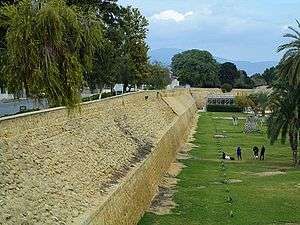
On his way to the Holy Land during the Third Crusade in 1187, Richard I of England's fleet was plagued by storms. He himself stopped first at Crete and then at Rhodes. Three ships continued on, one of which was carrying Joan of England, Queen of Sicily and Berengaria of Navarre, Richard's bride-to-be. Two of the ships were wrecked off Cyprus, but the ship bearing Joan and Berengaria made it safely to Limassol. Joan refused to come ashore, fearing she would be captured and held hostage by Isaac Komnenos of Cyprus, who hated all Franks. Her ship sat at anchor for a full week before Richard finally arrived on 8 May. Outraged at the treatment of his sister and his future bride, Richard invaded.[17]
Richard laid siege to Nicosia, finally met and defeated Isaac Komnenos at Tremetousia and became ruler of the island, but sold it to the Knights Templar.
The Frankish rule of Cyprus started from 1192 and lasted until 1489. During this time, Nicosia was the capital of the medieval Kingdom of Cyprus, the seat of Lusignan kings, the Latin Church and the Frankish administration of the island. During the Frankish rule, the walls of the city were built along with many other palaces and buildings, including the gothic St. Sophia Cathedral. The tombs of the Lusignan kings can be found there. The exonym Nicosia appeared with the arrival of the Lusignans. The French-speaking Crusaders either could not, or did not care to, pronounce the name Lefkosia, and tended to say "Nicosie" translated into Italian and then internationally known as "Nicosia".
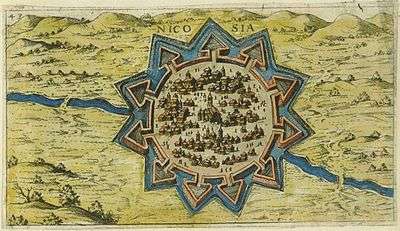
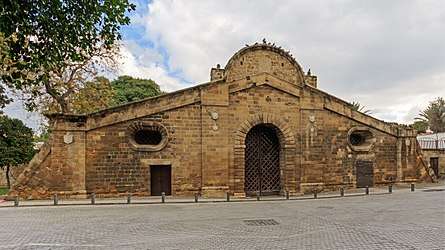
In 1374 Nicosia was occupied and ravaged by the Republic of Genoa and in 1426 from the Mamluk Sultanate.
In 1489, when Cyprus came under the rule of the Republic of Venice, Nicosia became their administrative centre and the seat of the Republic. The Venetian Governors saw it as a necessity for all the cities of Cyprus to be fortified due to the Ottoman threat.[18] In 1567 Venetians built the new fortifications of Nicosia, which are well-preserved until today, demolishing the old walls built by the Franks as well as other important buildings of the Frankish era including the King's Palace, other private palaces and churches and monasteries of both Orthodox and Latin Christians.[19] The new walls took the shape of a star with eleven bastions. The design of the bastion is more suitable for artillery and a better control for the defenders. The walls have three gates, to the North Kyrenia Gate, to the west Paphos Gate and to the east Famagusta Gate.[19] The river Pedieos used to flow through the Venetian walled city. In 1567 it was later diverted outside onto the newly built moat for strategic reasons, due to the expected Ottoman attack.[20]
Ottoman rule
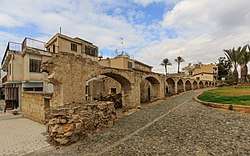
_-_TIMEA.jpg)
On 1 July 1570, the Ottomans invaded the island. On 22 July, Piyale Pasha having captured Paphos, Limassol and Larnaca marched his army towards Nicosia and laid siege to the city.[21] The city managed to last 40 days under siege until its fall on 9 September 1570. The story of the Cypriot martyr Arnaude de Rocas dates from the fall of Nicosia. Some 20,000 residents died during the siege and every church, public building, and palace was looted.[22] Nicosia had an estimated population of 21,000 before the Ottoman conquest, and based on the Ottoman census data of 1572, the population had been reduced to 1,100–1,200. The devastation of the city was so extensive that for the few years after the conquest, a number of villages in the island had a larger population than Nicosia.[23][24] The main Latin churches were converted into mosques, such as the conversion of the Saint Sophia Cathedral.
Nicosia was the seat of the Pasha, the Greek Archbishop, the Dragoman and the Qadi. The Palazzo del Governo of Venetian times became the seat of the Pasha, the governor of Cyprus, and the building was renamed as the Konak or Seraglio (Saray). The square outside was known as Seraglio Square or Sarayonu (literally front of the Saray), as it is known to the present day. The saray was demolished in 1904 and the present block of Government Offices built on the site.[25]
When the newly settled Turkish population arrived they generally lived in the north of the old riverbed. Greek Cypriots remained concentrated in the south, where the Archbishopric of the Orthodox Church was built. Other ethnic minority groups such as the Armenians and Latins came to be settled near the western entry into the city at Paphos Gate.[26]
The names of the 12 quarters into which Nicosia was originally divided at the time of the Ottoman Conquest are said to be derived from the 12 generals in command of divisions of the Ottoman army at the time. Each general being posted to a quarter, that quarter (with two exceptions) was known by his name as follows:
- General Ibrahim Pasha.
- General Mahmoud Pasha.
- General Ak Kavuk Pasha. (This is a nickname meaning "white cap.")
- General Koukoud Effendi.
- General Arab Ahmed Pasha.
- General Abdi Pasha, known as Chavush (Sergeant) from which rank he was probably promoted.
- General Haydar Pasha.
- General Karamanzade (son of a Caramanian, other names not given).
- General Yahya Pasha (now known as the Phaneromeni Quarter).
- General Daniel Pasha (name of quarter changed subsequently to Omerie in honour of the Caliph Omar who stayed there for a night when in Cyprus).
- Tophane (Artillery Barracks)
- Nebetkhane, meaning police station or quarters of the patrol.[25]
The names of the generals in command of the last two quarters have been lost:
Later the number of neighbourhoods was increased to 24. Each neighbourhood was organised around a mosque or a church, where mainly the respective Muslim and Christian communities lived.[27]
British rule

| Year | Pop. | ±% |
|---|---|---|
| 1881 | 11,536 | — |
| 1891 | 12,515 | +8.5% |
| 1901 | 14,481 | +15.7% |
| 1911 | 16,052 | +10.8% |
| 1921 | 11,831 | −26.3% |
| 1931 | 23,324 | +97.1% |
| 1946 | 34,485 | +47.9% |
| 1960 | 45,629 | +32.3% |
| Source for 1881–1960.[28] | ||
Nicosia came under the rule of the United Kingdom on 5 July 1878 in consequence of the Cyprus Convention.[29] The old Ottoman administrative headquarters (the Saray) was replaced in 1904 by a new building containing Law Courts, the Land Registry, and the Forestry, Customs, and Nicosia Commissioner's Offices.[25] Adjacent was the Nicosia Police headquarters, while opposite were the General Post Office and the Telegraph Office.[30] A Venetian Column, previously in a fenced courtyard near the Saray,[31] was restored on a new site in the summer of 1915 in the middle of Saray Square. The Nicosia column was presumably erected in compliment to the reigning Doge Francesco Donati about the year 1550.[25]
Just after the British Occupation a Municipal Council was constituted in Nicosia in 1882 for the general administration of public affairs within the city and for a certain area without the walls, under the presidency of a Mayor.[25] The first municipal offices were in Municipality Square (now the central municipal market), but in 1944 the offices were transferred temporarily to the d'Avila bastion and in 1952 this was made permanent with a decision to renovate the building.[32]
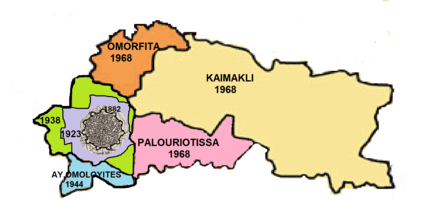
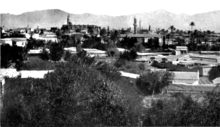
In 1923 the municipal limits were extended further (see map) and this new area was divided among several of the existing intramural Neighbourhoods.[33] In 1938 the boundary was extended to the present limits in the west and to the boundaries of Ayii Omoloyites, Palouriotissa, Kaimakli and Omorfita.[34] In 1944 the village authority of Ayii Omoloyites was absorbed, then, shortly after independence, Palouriotissa, Kaimakli and Omorfita were annexed to the city in 1968.[35]
In 1955 an armed struggle against British rule began aiming to unite the island with Greece, Enosis. The struggle was led by EOKA, a Greek Cypriot nationalist military resistance organisation,[36][37] and supported by the vast majority of Greek Cypriots. The unification with Greece failed and instead the independence of Cyprus was declared in 1960. During the period of the struggle, Nicosia was the scene of violent protests against British rule.[38][39]
Independence and division
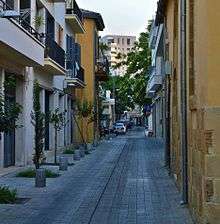
In 1960 Nicosia became the capital of the Republic of Cyprus, a state established by the Greek and Turkish Cypriots. In 1963, the Greek Cypriot side proposed amendments to the constitution, which were rejected by the Turkish Cypriot community.[40] During the aftermath of this crisis, on 21 December 1963, intercommunal violence broke out between Greek and Turkish Cypriots. Nicosia was divided into Greek and Turkish Cypriot quarters with the Green Line, named after the colour of the pen used by the United Nations officer to draw the line on a map of the city.[41] This resulted in Turkish Cypriots withdrawing from the government, and following more intercommunal violence in 1964, a number of Turkish Cypriots moved to the Turkish quarter of Nicosia, causing serious overcrowding.[42]
On 15 July 1974, there was an attempted coup d'état led by the Greek military junta to unite the island with Greece. The coup ousted president Makarios III and replaced him with pro-enosis nationalist Nikos Sampson.[43]
On 20 July 1974, the coup d'état precipitated the invasion of the island by the Turkish army.[44] The operation included two phases. The second phase of the Turkish invasion was performed on 14 August 1974, where the Turkish army advanced their positions, eventually capturing a total of 37% of Cypriot territory including the northern part of Nicosia. The fighting left the island with a massive refugee problem on both sides.[45]
On 13 February 1975 the Turkish Cypriot community declared the Turkish Federated State of Cyprus in the area occupied by Turkish forces.[46] On 15 November 1983, Turkish Cypriots proclaimed their independence as the Turkish Republic of Northern Cyprus.
On 23 April 2003, the Ledra Palace crossing was opened through the Green Line, the first time that crossing was allowed since 1974.[47] This was followed by the opening of Ayios Dometios/Metehan crossing point on 9 May 2003.[48] On 3 April 2008, the Ledra Street crossing was also reopened.[49]
From 30 October 2016 onwards, Nicosia became the only capital city in the world to have two time zones, after the parliament of the de facto Turkish Republic of Northern Cyprus abolished standard time and decided that Northern Cyprus remains at UTC+03:00 year-round, following Turkey's example.[50][51] The following year, due to criticism from the Turkish Cypriot public in the north, the Turkish Cypriot government decided to go back to standard time, following the rest of Europe.
Geography
Climate
Nicosia has a hot semi-arid climate (Köppen climate classification BSh) due to its low annual precipitation totals and annual temperature range.[52] The city experiences long, hot, dry summers, and cool to mild winters, with most of the rainfall occurring in winter. Winter precipitation is occasionally accompanied by sleet but rarely by snow. The accumulation of snow is particularly rare (last events occurred in 1950,1974 and 1997). There is occasionally light frost during the winter nights. At the Lefkopa weather station in Nicosia, the temperature reached 44.7 °C on 2 July 2017.[53]
| Climate data for Athalassa, Nicosia, elevation: 162 m (1991–2005 normals, extremes 1915–present) (Satellite view) | |||||||||||||
|---|---|---|---|---|---|---|---|---|---|---|---|---|---|
| Month | Jan | Feb | Mar | Apr | May | Jun | Jul | Aug | Sep | Oct | Nov | Dec | Year |
| Record high °C (°F) | 22.2 (72.0) |
26.2 (79.2) |
33.4 (92.1) |
39.0 (102.2) |
43.7 (110.7) |
43.3 (109.9) |
44.7 (112.5) |
43.6 (110.5) |
41.9 (107.4) |
38.3 (100.9) |
32.6 (90.7) |
25.2 (77.4) |
44.2 (111.6) |
| Average high °C (°F) | 15.5 (59.9) |
15.9 (60.6) |
19.2 (66.6) |
24.3 (75.7) |
29.7 (85.5) |
34.3 (93.7) |
37.2 (99.0) |
36.9 (98.4) |
33.5 (92.3) |
29.0 (84.2) |
22.1 (71.8) |
17.0 (62.6) |
26.2 (79.2) |
| Daily mean °C (°F) | 10.6 (51.1) |
10.6 (51.1) |
13.1 (55.6) |
17.1 (62.8) |
22.3 (72.1) |
26.9 (80.4) |
29.7 (85.5) |
29.4 (84.9) |
26.2 (79.2) |
22.3 (72.1) |
16.3 (61.3) |
12.0 (53.6) |
19.7 (67.5) |
| Average low °C (°F) | 5.7 (42.3) |
5.2 (41.4) |
7.0 (44.6) |
10.2 (50.4) |
14.8 (58.6) |
19.4 (66.9) |
22.2 (72.0) |
21.9 (71.4) |
18.8 (65.8) |
15.6 (60.1) |
10.4 (50.7) |
7.1 (44.8) |
13.2 (55.8) |
| Record low °C (°F) | −2.0 (28.4) |
−2.1 (28.2) |
0.4 (32.7) |
2.9 (37.2) |
7.5 (45.5) |
12.3 (54.1) |
16.0 (60.8) |
15.6 (60.1) |
13.1 (55.6) |
5.4 (41.7) |
0.9 (33.6) |
−0.1 (31.8) |
−2.1 (28.2) |
| Average precipitation mm (inches) | 54.7 (2.15) |
41.6 (1.64) |
28.3 (1.11) |
19.9 (0.78) |
23.5 (0.93) |
17.6 (0.69) |
5.8 (0.23) |
1.3 (0.05) |
11.7 (0.46) |
17.4 (0.69) |
54.6 (2.15) |
65.8 (2.59) |
342.2 (13.47) |
| Average precipitation days (≥ 1 mm) | 7.3 | 6.5 | 5.4 | 3.5 | 2.7 | 1.3 | 0.5 | 0.1 | 0.6 | 2.8 | 4.7 | 7.7 | 43.1 |
| Mean monthly sunshine hours | 182.9 | 200.1 | 238.7 | 267.0 | 331.7 | 369.0 | 387.5 | 365.8 | 312.0 | 275.9 | 213.0 | 170.5 | 3,314.1 |
| Source 1: Meteorological Service (Cyprus)[54][55] | |||||||||||||
| Source 2: Meteo Climat (record highs and lows)[56] | |||||||||||||
Cityscape
South of the Green Line
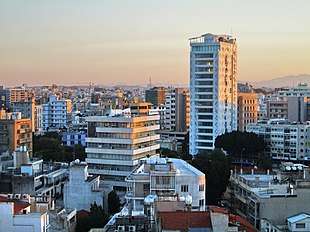
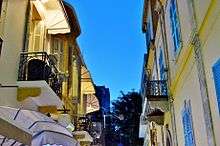
Ledra Street is in the middle of the walled city. The street has historically been the busiest shopping street of the capital and adjacent streets lead to the most lively part of the old city with narrow streets, boutiques, bars and art-cafés. The street today is a historic monument on its own. It is about 1 km (0.6 mi) long and connects the south and north parts of the old city. During the EOKA struggle that ran from 1955 to 1959, the street acquired the informal nickname The Murder Mile in reference to the frequent targeting of the British colonialists by nationalist fighters along its course.[57][58] In 1963, during the outbreak of hostilities between the Greek and Turkish Cypriot communities, following the announcement of amendments to the Cypriot Constitution, Turkish Cypriots withdrew to the northern part of Nicosia which became one of the many Turkish Cypriot enclaves which existed throughout the island. Various streets which ran between the northern and southern part of the city, including Ledra Street, were blockaded. During the Turkish army invasion of Cyprus in 1974, Turkish troops occupied northern Nicosia (as well as the northern part of Cyprus). A buffer zone was established across the island along the ceasefire line to separate the northern Turkish controlled part of the island, and the south. The buffer zone runs through Ledra Street. After many failed attempts on reaching agreement between the two communities, Ledra Street was reopened on 3 April 2008.
To the east of Ledra Street, Faneromeni Square was the centre of Nicosia before 1974. It hosts a number of historical buildings and monuments including Faneromeni Church, Faneromeni School, Faneromeni Library and the Marble Mausoleum. Faneromeni Church, is a church built in 1872 in the stead of another church located at the same site, constructed with the remains of La Cava castle and a convent. There rest the archbishop and the other bishops who were executed by the Ottomans in the Saray Square during the 1821 revolt. The Palace of the Archbishop can be found at Archbishop Kyprianos Square. Although it seems very old, it is a wonderful imitation of typical Venetian style, built in 1956. Next to the palace is the late Gothic Saint John cathedral (1665) with picturesque frescos. The square leads to Onasagorou Street, another busy shopping street in the historical centre.
The walls surrounding the old city have three gates. In The Kyrenia Gate which was responsible to the transport to the north, and especially Kyrenia, the Famagusta Gate which was responsible for the transport from Famagusta, Larnaca and Limassol and Karpasia, and the Paphos Gate for transport to the west and especially Paphos. All three gates are well-preserved.[59]
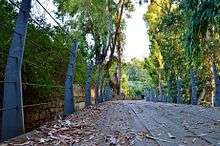
The historical centre is clearly present inside the walls, but the modern city has grown beyond. Presently, the main square of the city is Eleftheria (Freedom) Square, with the city hall, the post office and the library. The square, which is under renovation, connects the old city with the new city where one can find the main shopping streets such as the prestigious Stasikratous Street, Themistokli Dervi Avenue and Makarios Avenue.
Nicosia is also known for its fine museums. The Archbishop's Palace contains a Byzantine museum containing the largest collection of religious icons on the island. Leventis Municipal Museum is the only historical museum of Nicosia and revives the old ways of life in the capital from ancient times up to our days. Other interesting museums include the Folk Art Museum, National Struggle Museum (witnessing the rebellion against the British administration in the 1950s), Cyprus Ethnological Museum (House of Dragoman Hadjigeorgakis Kornesios, 18th century) and the Handicrafts Centre.
Nicosia also hosts an Armenian archbishopric, a small Buddhist temple, a Maronite archbishopric, and a Roman Catholic church.
North of the Green Line
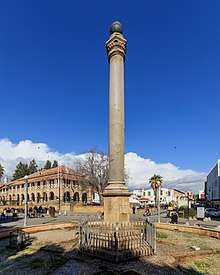
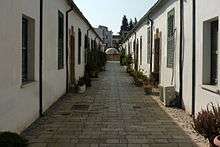
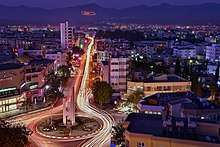
At the center of the walled city lies the Sarayönü Square. The square has been dubbed as "the heart of Nicosia" and historically has been the cultural center of the Turkish Cypriot community.[60] In the middle of the square stands the Venetian Column, known simply as "the Obelisk" ("Dikiltaş") to the locals and symbolic of the country's government.[60] The column was brought from the ancient city of Salamis by the Venetians in 1550.[61] The Girne Avenue connects Sarayönü to the Kyrenia Gate and the İnönü Square in front of it. The avenue has been described as "the symbol of the walled city", and is filled with numerous shops and restaurants.[62]
Next to the Ledra Street checkpoint is the Arasta area. The area was pedestrianized in 2013 and is home to a network of historic shopping streets, reflecting an eastern shopping tradition with food and traditional items.[63] Nearby Büyük Han, the largest caravanserai in the island and considered to be one of the finest buildings in Cyprus, was built in 1572 by the Ottomans and functions as a cultural center.[64][65] To the west of the Girne Avenue lies the Samanbahçe neighborhood, built in the 19th century by the government, considered to be the first example of social housing in the island. Still a residential area, the neighborhood is considered to be one of the best representations of the Cypriot culture.[66] Another central point in the walled city is the Selimiye Mosque, originally built as the St. Sophia Cathedral. The mosque is the chief religious center in Northern Cyprus. It was built between 1209 and 1228 by the Latin Church of Cyprus, in a Gothic style resembling French cathedrals.[67] Next to the mosque is the Bedesten, a large Greek church in the Byzantine and Gothic styles, built in the 14th century. It was used as a marketplace in the Ottoman era. Today, it is used as a cultural center where various cultural activities such as concerts and festivals take place.[68][69]
The quarters of Nicosia outside the walled city are more spacious than the walled city, with wider roads and junctions. These areas are characterized by multi-floor concrete buildings. In the outskirts of the city, a number large and imposing villas have been built that belong to the middle and upper-classes.[70] The Dereboyu Avenue serves as the modern heart of the northern part and is its center of entertainment.
Politics and administration
Governance of the metropolitan area

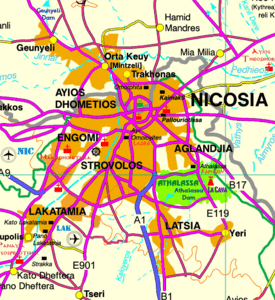
Greater Nicosia is administered by several municipalities. In the centre is the city municipality of Nicosia itself (see below). Other municipalities are Strovolos, Lakatamia, Latsia, Aglandjia, Engomi, Agios Dhometios and the newly formed (as of 2011) Yeri & Tseri.
The population of the conurbation is 300,000 (2011 census, plus Turkish Cypriot administered census of 2006) of which 100,000 live within the Nicosia municipal area. Because Nicosia municipality has separate communal municipal administrations, the population of Strovolos (67,904 (2011 Census)) is actually the largest of all the local authorities in Greater Nicosia.
Within Nicosia municipality, most of the population resides in the more recently annexed outlying areas of Kaimakli, Pallouriotissa, Omorfita and Ayii Omoloyites.
There is no metropolitan authority as such for Greater Nicosia and various roles, responsibilities and functions for the wider area are undertaken by the Nicosia District administration, bodies such as the Nicosia Water Board and, to some extent, Nicosia municipality.
The Nicosia Water Board supplies water to the following municipalities: Nicosia, Strovolos, Aglandjia, Engomi, Ay. Dometios, Latsia, Geri and Tseri. The board consists of three persons nominated by the Council of each municipality, plus three members appointed by the government, who are usually the District Officer of Nicosia District, who chairs the Board, the Accountant General and the Director of the Water Department. The board also supply Anthoupolis and Ergates, for whom the government provide representatives. Thus the board is in the majority controlled by the municipalities of Greater Nicosia in providing this vital local government service.[71]
The Nicosia Sewerage Board, is likewise majority controlled by the municipalities of Greater Nicosia. It is chaired ex officio by the Mayor of Nicosia and consists of members chosen by the municipalities of Nicosia (6 members), Strovolos (5 members), Aglandjia (2 members), Lakatamia (2 members), Ay. Dometios (2 members), Engomi (2 members), Latsia (1 member). The sewage treatment plant is at Mia Milia. The Nicosia Sewerage System serves a population of approximately 140,000 and an area of 20 km2 (8 sq mi). Approximately 30% of the influent is contributed by the Turkish Cypriot Side.[72]
Public transport is not controlled by the local authorities, but comes under the Nicosia District administration, which is an arm of the Ministry of the Interior. Transport services (primarily bus and taxi) are provided by private operators such as OSEL. [73] In late 2019 the contract for providing transport services in the district of Nicosia was awarded via tender to a private consortium which is expected to take over the system on Jyly 5th 2020. [74] [75]
Nicosia Municipality
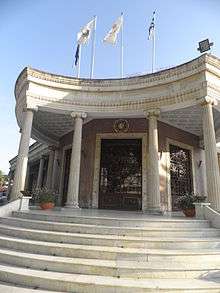
The Nicosia Municipality is responsible for all the municipal duties within the walled city and the immediately adjacent areas. The Constitution states that various main government buildings and headquarters must be situated within the Nicosia municipal boundaries.[76] However separate municipalities are prescribed by the constitution for in the five largest towns, including Nicosia,[77] and in the case of Nicosia the separate administration was established in 1958. The Turkish Municipal Committees (Temporary Provisions) Law, 1959[78] established a municipal authority run by a "Turkish Municipal Committee", defined as "the body of persons set up on or after the first day of July, 1958, in the towns of Nicosia, Limassol, Famagusta, Larnaca and Paphos by the Turkish inhabitants thereof for the purpose of performing municipal functions within the municipal limits of such towns".The Nicosia Turkish Municipality, founded in 1958, carries out municipal duties in the northern and north-western part of city.[79] The remaining areas, in the south and east of the city, are administered by Nicosia Municipality.
Nicosia Turkish Municipality
The first attempt to establish a Nicosia Turkish Municipality was made in 1958. In October 1959, the British Colonial Administration passed the Turkish Municipality Committees law. In 1960 with the declaration of independence of Cyprus, the Constitution of the Republic of Cyprus gave Turkish Cypriots the right to establish their own municipality.[80][81][82] As negotiations between the two sides to establish separate municipalities failed in 1962, implementing legislation was never passed.[83][84] Since the complete division of Nicosia following the Turkish Invasion in 1974, the Nicosia Turkish Municipality has become the de facto local authority of northern Nicosia. The Nicosia Turkish Municipality is a member the Union of Cyprus Turkish Municipalities.[85] The mayor is Mehmet Harmancı from the Communal Democracy Party.
Other municipalities in Greater Nicosia
Until 1986 there were no suburban municipalities. Then, following the procedures in the Municipal Law 111/1985, Strovolos, Engomi, Ay. Dometios, Aglandjia, Latsia and Lakatamia were erected into municipalities.[86] Each municipal council has the number of members described in the Municipal Law 111/1985 depending on the population figures. All members of the council are elected directly by the people for a period of 5 years.
Administrative divisions and demographics
.png)
Nicosia within the city limits is divided into 29 administrative units, according to the latest census. This unit is termed in English as quarter, neighbourhood, parish, enoria or mahalla. These units are: Ayios Andreas(formerly Tophane), Trypiotis, Nebethane, Tabakhane, Phaneromeni, Ayios Savvas, Omerie, Ayios Antonios (St. Anthony), St. John, Taht-el-kale, Chrysaliniotissa, Ayios Kassianos (Kafesli), Kaïmakli, Panayia, St Constantine & Helen, Ayioi Omoloyites, Arab Ahmet, Yeni Jami, Omorfita, Ibrahim Pasha, Mahmut Pasha, Abu Kavouk, St. Luke, Abdi Chavush, Iplik Pazar and Korkut Effendi, Ayia Sophia, Haydar Pasha, Karamanzade,[87] and Yenişehir/Neapolis.[88]
The municipality of Strovolos, established in 1986, is the second largest municipal authority in Cyprus in terms of population after Limassol and encompasses the southern suburbs of the capital immediately adjacent to Nicosia municipality.[89] Lakatamia, Latsia, Geri and Aglandjia are other separate municipalities in the Nicosia metropolitan area.
The town of Gönyeli is now conurbated with the northern suburbs. Previously a village authority, it now functions as a municipality[90] within the same area[91] The suburbs immediately to the north of the city have not been erected into municipalities. The village authority of Hamitköy (also known as Hamid Mandres) was heavily urbanized[92] and was included within the borders of Nicosia Turkish Municipality[93] as a Nicosia neighbourhood headed by a muhtar.[94] Ortakeuy Village authority[95] has similarly been redefined as a neighbourhood of Nicosia Turkish Municipality.
Culture
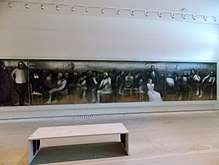
The Cyprus Museum in Nicosia is the largest and oldest archaeological museum in Cyprus. In old Nicosia, the Ethnological Museum (Hadjigeorgakis Kornesios Mansion) is the most important example of urban architecture of the last century of Ottoman domination which survives in old Nicosia. Today, the mansion which was awarded the Europa Nostra prize for its exemplary renovation work, functions as a museum where a collection of artifacts from the Byzantine, Medieval and Ottoman periods are displayed. Other museums in Nicosia include the Cyprus Museum of Natural History and the Leventis Municipal Museum of Nicosia and Von World Pens Hall in the south. In the north, the Dervish Pasha Mansion, similar in architecture to the Hadjigeorgakis Kornesios Mansion, serves as an ethnological museum, displaying Ottoman and archaeological artifacts.[96] Other museums include the Lusignan House,[97] the Mevlevi Tekke Museum, associated with the sect of the Whirling Dervishes,[98] and the Lapidary Museum.[99]
Art galleries in Nicosia include the Leventis Gallery, which hosts over 800 paintings from Cypriot, Greek or European artists.
Nicosia offers a wide variety of musical and theatrical events, organized either by the municipality or independent organizations. Halls and theatres used for this purpose include:
- The Cyprus National Theatre, which contains two performance spaces:[100]
- the 550-seat Lyric Theater with a bold exterior but an intimate theatrical environment. Its design minimizes the distance from actor to audience;
- the 150-seat New Theater, which is an open-ended workshop space, with simple galleries around the room. The stage can be set in the center, at the ends, or to one side of the room, and the space can be opened to the private garden beyond.
- The Pallas Cinema-Theatre which was renovated from a near derelict state in 2008.[101]
- Theatro Ena[102]
- Maskarini Theatre[103][104]
- Dionysos Theatre[105][106]
- Melina Mercouri Hall[107]
Nicosia's universities also boast an impressive array of facilities, and many churches and outdoor spaces are used to host cultural events. The Near East University hosts the Atatürk Cultural and Conference Centre, with 700 seats.[108]
Nicosia hosted the Miss Universe 2000 pageant.[109]
In June 2011, Nicosia launched a failed campaign to become the European Capital of Culture for 2017.[110]
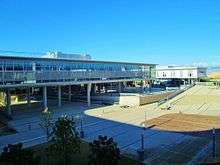
Education
Nicosia has a large student community as it is the seat of eight universities, the University of Cyprus (UCY), the University of Nicosia, the European University Cyprus, the Open University of Cyprus, Frederick University, Near East University, the University of Mediterranean Karpasia, Cyprus International University.
Economy
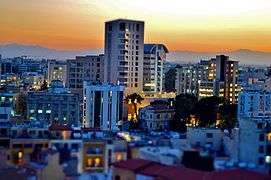
Nicosia is the financial and business heart of Cyprus. The city hosts the headquarters of all Cypriot banks namely the former Cyprus Popular Bank (also known as Laiki Bank), Bank of Cyprus, the Hellenic Bank. Further, the Central Bank of Cyprus is located in the Acropolis area of the Cypriot capital. A number of international businesses base their Cypriot headquarters in Nicosia, such as the big four audit firms PWC, Deloitte, KPMG and Ernst & Young. International technology companies such as NCR and TSYS have their regional headquarters in Nicosia. The city is also home to local financial newspapers such as the Financial Mirror and Stockwatch. Cyprus Airways had its head offices in the entrance of Makariou Avenue.[111] According to a recent UBS survey in August 2011, Nicosia is the wealthiest per capita city of the Eastern Mediterranean and the tenth richest city in the world by purchasing power in 2011.[112]
Transport
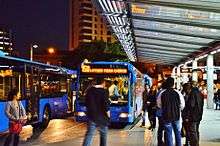
Nicosia is linked with other major cities in Cyprus via a modern motorway network. The A1 connects Nicosia with Limassol in the south with the A6 going from Limassol onto Paphos. The A2 links Nicosia with the south eastern city of Larnaca with the A3 going from Larnaca to Ayia Napa. The A9 connects Nicosia to the west Nicosia district villages and the Troodos mountains. The capital is also linked to the 2 international airports: Larnaca International Airport and Paphos International Airport. (Nicosia International Airport ceased commercial operations in 1974; it is located within the Green Line buffer zone, and is used as the headquarters of the United Nations Peacekeeping Force in Cyprus.)
Public transport within the city is served by a new bus service. Bus services in Nicosia are run by OSEL.[113] In the northern part, the company of LETTAŞ provides this service.[114] Many taxi companies operate in Nicosia. Fares are regulated by law and taxi drivers are obliged to use a taximeter.
In 2010, as part of the Nicosia Integrated Mobility Plan, a pre-feasibility study for a proposed tram network has taken place and sponsored by the Ministry of Communications and Works. The study compared two scenarios, with and without the operation of a tramway in terms of emitted polluting loads.[115]
In 2011, the Nicosia Municipality introduced the Bike in Action scheme, a bicycle sharing system which covers the Greater Nicosia area. The scheme is run by the Inter-Municipal Bicycle Company of Nicosia (DEPL).[116]
There is no train network in Cyprus however plans for the creation of an intercity railway are under way. The first railway line on the island was the Cyprus Government Railway which operated from 1905 to 1951. It was closed down due to financial reasons.[117]
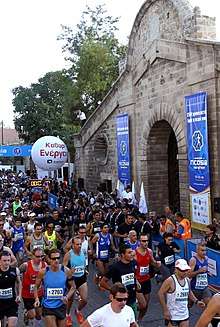
Sports
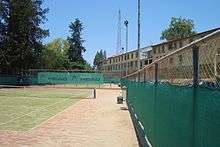
Football is the most popular sport in Cyprus, and Nicosia is home of three major teams of the island; APOEL, Omonia and Olympiakos. APOEL and Omonia are dominant in Cypriot football. There are also many other football clubs in Nicosia and the suburbs. The city also hosts Çetinkaya, Yenicami, Küçük Kaymaklı and Gönyeli, four of the major Turkish Cypriot clubs. Nicosia is also home to Ararat FC, the island's only Armenian FC.
Nicosia is also the home for many clubs for basketball, handball and other sports. APOEL and Omonia have basketball and volleyball sections and Keravnos is one of the major basketball teams of the island. The Gymnastic Club Pancypria (GSP), the owner of the Neo GSP Stadium, is one of the major athletics clubs of the island. Also, all teams in the Futsal First Division are from Nicosia. In Addition, European University and SPE Strovolou are the two best handball teams in Cyprus and they are both located in Nicosia.
Nicosia has some of the biggest venues in the island; the Neo GSP Stadium, with capacity of 23,400, is the home for the national team, APOEL, Olympiakos and Omonia. Makario Stadium has a capacity of 16,000. In the north, the Nicosia Atatürk Stadium has a capacity of 28,000.[118] The Eleftheria Indoor Hall is the biggest basketball stadium in Cyprus, with capacity of 6,500 seats and is the home for the national team, APOEL and Omonia. The Lefkotheo indoor arena is the volleyball stadium for APOEL and Omonia.
In Nicosia in 2010 and 2012. took place Nicosia Marathon, organized by Athanasios Ktorides Foundation, and attracted more than 7,000 participants.[119][120]
Nicosia hosted the 2000 ISSF World Cup Final shooting events for the shotgun. Also the city hosted two basketball events; the European Saporta Cup in 1997 and the 2005 FIBA Europe All Star Game in the Eleftheria Indoor Hall. Another event which was hosted in Nicosia were the Games of the Small States of Europe in 1989 and 2009.
Notable people

- Peter I of Cyprus (1328–1369), King of Cyprus
- Kıbrıslı Mehmed Kamil Pasha (1833–1913), Grand Vizier of the Ottoman Empire
- Fazıl Küçük (1906–1984), former Vice President of the Republic of Cyprus (1960–1963)
- Glafkos Klerides (1919–2013), former President of the Republic of Cyprus (1993–2003)
- Tassos Papadopoulos (1934–2008), former President of the Republic of Cyprus (2003–2008)
- Marios Garoyian, former President of the House of Representatives of Cyprus (2008–2011)
- Benon Sevan, Assistant Secretary-General of the United Nations (1992–2005) and the Head of the Oil for Food program (1996–2005)
- Nicos Tornaritis, politician and jurist, member of the House of Representatives and Consultant of the Republic of Cyprus
- Neoklis Kyriazis (1877–1956), historian and member of the National Council of Cyprus
- Alparslan Türkeş (1917–1997), Turkish nationalist politician, founder of the Nationalist Movement Party in Turkey
- Kutlu Adalı (1935–1996), journalist, poet and socio-political researcher and peace advocate
- Christopher A. Pissarides, Nobel Prize winner in Economics
- Mustafa Djamgoz, professor of cancer biology at Imperial College London
- Manoug Parikian (1920–1987), violinist and violin professor in the UK
- Nicolas Economou (1953–1993), concert pianist, composer, arranger, conductor and organizer of music festivals
- Mick Karn (1958–2011), musician, bassist of the pop group Japan
- Michalis Hatzigiannis, singer
- Alkinoos Ioannidis, singer
- Giorgos Papadopoulos, composer, singer
- Diam's, French rap singer
- Hazar Ergüçlü, actress on the Turkish drama Medcezir
- Suat Günsel, businessman and founder of the Near East University
- Sevgül Uludağ, journalist, activist
- Aleksandar Vezenkov, basketball player
- Michael Bisping, MMA fighter
International relations
Twin towns and sister cities
Twinnings:[121]











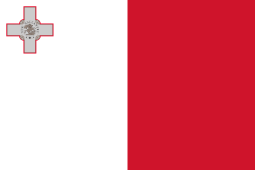

See also
References
- "Population – Place of Residence, 2011". Statistical Service of Cyprus (CYSTAT). 17 April 2014. Archived from the original on 16 October 2014.
- "KKTC 2011 Nüfus ve Konut Sayımı" [TRNC 2011 Population and Housing Census] (PDF) (in Turkish). TRNC State Planning Organization. 6 August 2013.
- Kempen, Ronald van; Vermeulen, Marcel; Baan, Ad (2005). Urban Issues and Urban Policies in the New EU Countries. Ashgate. p. 207. ISBN 978-0-7546-4511-5.
- "World's richest cities by purchasing power". UBS. 2018. Archived from the original on 3 August 2018. Retrieved 30 May 2018.
- Michaelides, Demetrios; Pilides, Despina (2012). "Nicosia from the Beginnings to the Roman Ledroi". In Michaelides, D. (ed.). Historic Nicosia. Nicosia: Rimal Publications. pp. 4–8.
- Papacostas, Tasos (2012). "Byzantine Nicosia: 650–1191". In Michaelides, D. (ed.). Historic Nicosia. Nicosia: Rimal Publications. pp. 87–88.
- "Nicosia Municipality". Nicosia.org.cy. Archived from the original on 15 March 2012. Retrieved 21 July 2012.
- World and its Peoples: Greece and the Eastern Balkans. Marshall Cavendish, 2010.
- Michaelides and Pallides 2012, p. 52.
- "Nicosia Municipality". Nicosia.org.cy. Archived from the original on 7 March 2012. Retrieved 10 March 2012.
- "Saint Tryphillius". Saintsoftheday108.blogspot.com. Retrieved 10 March 2012.
- Demetrios and Pallides, p. 59.
- Papacostas 2012, p. 103.
- "Nicosia Municipality". Nicosia.org.cy. Archived from the original on 5 March 2012. Retrieved 10 March 2012.
- Papacostas 2012, pp. 83–84.
- Papacostas 2012, pp. 99–100.
- "The Crusades – home page". Boisestate.edu. Archived from the original on 1 October 2009. Retrieved 10 March 2012.
- "Nicosia Municipality". Nicosia.org.cy. Archived from the original on 5 March 2012. Retrieved 10 March 2012.
- "Nicosia Municipality". Nicosia.org.cy. Archived from the original on 6 March 2012. Retrieved 10 March 2012.
- "Nicosia" (PDF). Archived from the original (PDF) on 22 April 2012. Retrieved 12 March 2013.
- "Nicosia Municipality". Nicosia.org.cy. Archived from the original on 7 March 2012. Retrieved 10 March 2012.
- "Cyprus – Historical Setting – Ottoman Rule". Historymedren.about.com. 17 June 2010. Retrieved 10 March 2012.
- Theocharides, Ioannis; Stavrides, Theoharis (2012). "Nicosia Under Ottoman Rule 1570–1878: Part I". In Michaelides, D. (ed.). Historic Nicosia. Rimal Publications. p. 237.
- Jennings, Ronald C. (1993). Christians and Muslims in Ottoman Cyprus and the Mediterranean World, 1571–1640. New York, London: New York University Press. p. 256.
- A description of the historic monuments of Cyprus. Studies in the archaeology and architecture of the island, by George Jeffery, Architect, 1918
- "Nicosia". Conflictincities.org. Retrieved 10 March 2012.
- Coexistence in the Disappeared Mixed Neighbourhoods of Nicosia, by Ahmet An (Paper read at the conference, "Nicosia: The Last Divided Capital in Europe", organized by the London Metropolitan University on 20 June 2011)
- "PRIO". Prio-cyprus-displacement.net. Retrieved 29 March 2017.
- "Nicosia Municipality". Nicosia.org.cy. Archived from the original on 6 March 2012. Retrieved 10 March 2012.
- See map drawn in 1952 published in "Romantic Cyprus", by Kevork Keshishian, 1958 edition
- "Levkosia, the capital of Cyprus" by Archduke Louis Salvator, 1881
- Municipality web site, section on Municipal Building retrieved August 2013
- Order No. 397 published in Cyprus Gazette No. 1597, 4 August 1923
- Cyprus Gazette No. 2676. 23 September 1938, Supplement No.3:The Municipal Corporations Laws, 1930 to 1938 – Limits of the Municipal Corporation of Nicosia
- Nicosia Capital of Cyprus by Kevork Keshishian, pub 1978
- "EOKA (Ethniki Organosis Kyprion Agoniston)". Retrieved 12 December 2008.
- "War and Politics – Cyprus". Archived from the original on 16 December 2008. Retrieved 12 December 2008.
- Bahceli, Simon (28 November 2011). "Fed up with separation Cypriot youths seek change". Reuters. Archived from the original on 13 May 2019.
Camped on a tiny sliver of land that forms part of a United Nations-controlled buffer zone in the heart of Nicosia, these 18-year-olds and their friends are calling for a return to a way of life they have never known, one in which their communities can mix freely... It is fitting that the youths’ movement is on Ledra Street, a bustling thoroughfare where the first seeds of Cyprus's separation were sown in the 1950s.
- "30. British Cyprus (1914–1960)". University of Central Arkansas Department of Political Science. Archived from the original on 13 May 2019.
The EOKA rebelled against the British colonial government on April 1, 1955. EOKA insurgents attacked police stations in Nicosia and Kyrenia on June 19, 1955. One individual was killed and fourteen individuals were injured in an explosion near the Central Police Station in Nicosia on June 21, 1955... Turkish Cypriots demonstrated against the British colonial government in Nicosia on January 27–29, 1958. Seven Turkish Cypriots were killed in clashes with British soldiers in Nicosia on January 27, 1958.
- Solsten, Eric. "The Republic of Cyprus". US Library of Congress. Retrieved 18 June 2012.
- "Nicosia Municipality". Nicosia.org.cy. Archived from the original on 7 March 2012. Retrieved 10 March 2012.
- Solsten, Eric. "Intercommunal Violence". US Library of Congress. Retrieved 18 June 2012.
- "CYPRUS: Big Troubles over a Small Island". TIME. 29 July 1974.
- "Nicosia Municipality". Nicosia.org.cy. Archived from the original on 17 April 2013. Retrieved 10 March 2012.
- The Cyprus Conspiracy: America, Espionage and the Turkish Invasion. By Brendan O'Malley, Ian Craig. Books.google.com. 25 August 2001. ISBN 9781860647376. Retrieved 10 March 2012.
- Malcolm Nathan Shaw, International Law, Cambridge University Press, 2003, ISBN 978-0-521-82473-6, p. 212.
- "Emotion as Cyprus border opens". BBC News. 23 April 2003. Retrieved 21 July 2012.
- "Report of the Secretary-General on the United Nations Operation in Cyprus". Docs.google.com. Retrieved 21 July 2012.
- "Symbolic Cyprus crossing reopens". BBC News. 3 April 2008. Retrieved 21 July 2012.
- "Cyprus to have two time zones, north to follow Turkey in refusing to turn clocks back". Cyprus Mail. 8 September 2016. Retrieved 25 November 2016.
- "Clocks going back tonight". Cyprus Mail. 29 October 2016. Retrieved 25 November 2016.
- Map
- "Ogimet daily weather summary".
- "Meteorological Service – CLIMATOLOGICAL DATA, Athalassa 1991 – 2005" (PDF). August 2011.
- "Recent weather data". Retrieved 20 May 2020.
- |"Station Nicosie" (in French). Meteo Climat. Retrieved 17 December 2018.
- "The First Move". Time Magazine. 27 August 1956. Retrieved 20 March 2008.
- "War and Politics-Cyprus". Britains-smallwars.com. Archived from the original on 16 December 2008. Retrieved 10 March 2012.
- Keshishian, Kevork K. (1978). Nicosia: Capital of Cyprus Then and Now, p. 78-83, The Mouflon Book and Art Centre.
- "İki paradan bir milyona... Saraçoğlu'ndan Ecevit'e..." kibris.net. Archived from the original on 4 March 2016. Retrieved 3 January 2015.
- "Venedik Sütunu". Nicosia Turkish Municipality. Archived from the original on 3 January 2015. Retrieved 3 January 2015.
- "Girne Caddesi'nin dokusu değişecek". Kıbrıs Postası. Archived from the original on 4 March 2016. Retrieved 3 January 2015.
- "Arasta". LTB. Archived from the original on 4 January 2015. Retrieved 4 January 2015.
- "Arasta boş, Büyük Han kaynıyor!". Kıbrıs Postası. Archived from the original on 4 March 2016. Retrieved 4 January 2015.
- "Büyük Han". LTB. Archived from the original on 4 January 2015. Retrieved 4 January 2015.
- "Samanbahçe Evleri". Nicosia Turkish Municipality. Archived from the original on 4 January 2015. Retrieved 4 January 2015.
- "Selimiye Cami". LTB. Archived from the original on 4 January 2015. Retrieved 4 January 2015.
- "Trio Arion oda müziği konserler dizisi yarın başlıyor". Kıbrıs Postası. Archived from the original on 25 July 2015. Retrieved 4 January 2015.
- Dreghorn, William. "The Antiquities of Turkish Nicosia". stwing.upenn.edu. Retrieved 4 January 2015.
- "Urbanization in Cyprus". Eastern Geography Review. Archived from the original on 18 August 2012. Retrieved 6 January 2015.
- Official web site of the Nicosia Water Board (extract 20/5/13)
- Official web site of the Nicosia Sewerage Board (extract 20/5/13)
- Official web site of Organisation for Communications of Nicosia District
- Nicosia bus services in the hands of Kapnos consortium, InCyprus/Phileleftheros, Nicosia, 21 January 2020
- Λεωφορεία Λευκωσίας: Υπογράφηκε η σύμβαση, Politis, Nicosia, 24 January 2020
- e.g. Constitution of Cyprus Article 153, s2 – "The seat of the High Court shall be in the capital of the Republic."
- Constitution of Cyprus Article 173 – "Separate municipalities shall be created in the five largest towns of the Republic, that is to say, Nicosia, Limassol, Famagusta, Larnaca and Paphos by the Turkish inhabitants thereof"
- Law 1959 c3
- Phoebe Koundouri, Water Resources Allocation: Policy and Socioeconomic Issues in Cyprus, p. 70.
- Phoebe Koundouri, Water Resources Allocation: Policy and Socioeconomic Issues in Cyprus, Springer, 2010, p. 70.
- The Middle East: a survey and directory of the countries of the Middle East, Europa Publications., 1966, p. 171.
- "The Constitution – Appendix D: Part 12 – Miscellaneous Provisions" (in Greek). Cyprus.gov.cy. Retrieved 10 March 2012.
- "The Issue of Separate Municipalities and the Birth of the New Republic: Cyprus 1957–1963 (University of Minnesota Press, 2000)". Cyprus-conflict.net. Retrieved 10 March 2012.
- "The Library of Congress – Country Studies: Cyprus – Ch. 4 – 1960 Constitution". Lcweb2.loc.gov. 27 July 2010. Retrieved 10 March 2012.
- Reddick, Christopher G. (19 August 2010). Comparative E-Government. ISBN 1-4419-6535-1.
- "Official web site of Engomi municipality, history section (Greek version)". Archived from the original on 26 August 2013. Retrieved 20 May 2013.
- Census of Cyprus (available from Statistical Service, Nicosia). Document: Population – Place of Residence, 2011, Table C. Municipality/Community, Quarter and Street Index published by Ministry of Information (CILIS_streets_022011)
- Official Gazette of the Republic No. 4341 and dated 25.01.2010
- Official web site of Strovolos municipality, history section (English version)
- Gonyeli Municipal web site August 2013
- The authority has the population, economic viability and consent of the (original) inhabitants prescribed in the Municipalities Law (see Law 11/1985), without having been formally recognised as a municipality under that law. See also www.prio-cyprus-displacement.net/default_print.asp?id=300 retrieved August 2013
- "PRIO". Prio-cyprus-displacement.net. Retrieved 29 March 2017.
- "Archived copy". Archived from the original on 3 August 2012. Retrieved 15 April 2012.CS1 maint: archived copy as title (link) (retrieved August 2013)
- retrieved August 2013 Archived 18 May 2014 at the Wayback Machine
- "PRIO". Prio-cyprus-displacement.net. Retrieved 29 March 2017.
- "Dervish Pasha Mansion". TRNC Department of Antiquities. Archived from the original on 2 January 2015. Retrieved 2 January 2015.
- "Lusignan House". TRNC Department of Antiquities. Archived from the original on 2 January 2015. Retrieved 2 January 2015.
- "Mevlevi Tekke Museum". TRNC Department of Antiquities. Archived from the original on 2 January 2015. Retrieved 2 January 2015.
- "Lapidary Museum". TRNC Department of Antiquities. Archived from the original on 2 January 2015. Retrieved 2 January 2015.
- The Cyprus National Theatre at nicosia.org.cy Accessed 2 February 2017
- Pallas Cinema-Theatre at nicosia.org.cy Accessed 2 February 2017
- Theatro Ena at nicosia.org.cy Accessed 2 February 2017
- Maskarini Theatre ay maskarini.com Archived 16 September 2017 at the Wayback Machine Accessed 2 February 2017
- Maskarini Theatre at nicosia.org.cy Accessed 2 February 2017
- Dionysos Theatre at theatrodionysos.org Accessed 2 February 2017
- Dionysos Theatre at nicosia.org.cy Accessed 2 February 2017
- Melina Mercouri Hall at nicosia.org.cy Accessed 2 February 2017
- "Atatürk Kültür ve Kongre Merkezi". Near East University. Archived from the original on 24 October 2017. Retrieved 24 October 2017.
- "Cyprus to host Miss Universe in millennium". Agence France Press. 1 July 1999.
- "Nicosia-Cyprus presents candidacy for European Cultural Capital". Citiesintransition.posterous.com. Retrieved 10 March 2012.
- Addresses Cyprus Airways
- "The most expensive and richest cities in the world – A report by UBS". Citymayors.com. 18 August 2011. Retrieved 10 March 2012.
- "Οργανισμός Συγκοινωνιών Επαρχίας Λευκωσίας". Osel.com.cy. Retrieved 21 July 2012.
- "Kurban bayramı yarın başlıyor". Star Kıbrıs. 19 December 2007. Retrieved 28 April 2012.
- (in Greek) THE NICOSIA INTEGRATED MOBILITY MASTER PLAN REPUBLIC OF CYPRUS – Ministry of Communications and Works
- "Ποδηλατο Εν Δρασει / Home". Podilatoendrasi.com.cy. Archived from the original on 26 December 2011. Retrieved 21 July 2012.
- "Study underway for Cyprus railway network". Famagusta Gazette. 12 June 2011. Retrieved 13 June 2012.
- Nicosia Marathon
- SPORTS: Voyiatzis wins Nicosia marathon, Financial Mirror 10 December 2012
- "Twinnings". Nicosia Municipality. Retrieved 7 January 2015.
- Nicosia Municipality (south) website
- Nicosia Municipality (north) website
- Nicosia Municipality website – Transportation
- Cyprus Island – Nicosia
- The World of Cyprus bilingual information portal with background on folk culture and Byzantine influences
Bibliography
- See also: Bibliography of the history of Nicosia
External links
| Wikimedia Commons has media related to Nicosia. |
- English-language website for Municipality of Nicosia (Λευκωσια)

